Brendan Jon Philip – 20 August, 2015
In responding to the historicised rubric and sculptural brief of this show the four artists presenting their work here have each explored a specific spatiality, marking a trace through location in an attempt to negotiate the external factors that continue to influence art production - despite all attempts to resist and negate those very factors.
Dunedin
Deanna Dowling, Tomas Richards, Cobi Taylor, Robyn Jordaan
A Tragic Delusion
Curated by Chloe Geoghegan
5 August - 29 August 2015
Split between the Blue Oyster Gallery and a vacant warehouse space above a bookbinder several blocks away, A Tragic Delusion attempts to map a certain lineage of artist run initiatives in New Zealand and investigate how this narrative is reflected in emerging contemporary practices. Curated by Blue Oyster director Chloe Geoghegan, the scope of this exhibition foregrounds her strong interest in experimental and under-the-radar practices in artist driven spaces filtered through the particular tradition of such ventures in Dunedin. Geoghegan acknowledges the implicit hegemonic negotiation of such practices with the dominant, ‘authorised’ arts structures of Aotearoa by locating the Blue Oyster as it is: a CNZ responsible institution now outside of, but growing from the fertile soil of independently minded grassroots initiatives such as The Honeymoon Suite and the Super 8 collective.
The location of the off-site exhibition space in Dunedin’s historic warehouse district is an imperative choice. Once full of decaying, low-rent spaces this area has most recently been the site an aggressive gentrification that trumpeted itself loudly under the banner of the Dunedin Street Art Festival last year. Self-identifying as fostering and ‘creative quarter’, the cruel ironies of this development were thrown under a harsh light by the public programme screening of Dereliction, a short film by Kim Pieters documenting a four hour exhibition of her paintings and drawings from 1996. Populated by figures from the Dunedin arts scene and featuring performances from experimental music luminaries Sandoz Lab Technicians, Donald McPherson, and Flies Inside the Sun, the event took place in the appropriately derelict Vogel House, a block from the off-site exhibition space of A Tragic Delusion. Vogel House is now boutique wine shop. Geoghegan addresses the implicit complicity of the Blue Oyster in these processes by being accountable to the official structures that also support and endorse such developments. She however keeps an ideological space open for the continuing cycle of independent practices now and into the future.
In responding to the historicised rubric and sculptural brief of this show the four artists presenting their work here have each explored a specific spatiality, marking a trace through location in an attempt to negotiate the external factors that continue to influence art production - despite all attempts to resist and negate those very factors.
Tomas Richards’ performative intervention Traversing Particles exchanges physical material between the two exhibition spaces, most dramatically removing a floorboard from the gallery revealing the foundational space beneath. Relocating this floorboard and other items almost arbitrarily, giving a sense of a movement that remains incomplete. The work speaks to a mutability of location; the function of a room determined by the objects and activities that occupy it at any given time: this room is empty / this room is a work space / this room is a gallery / this room is a venue for performance.
Richards’ material interchange suggests some kind of negotiation between the two spaces that underscores a kinship or sympathy between them. It could be seen as the exploratory phase of colonisation, opening the potential of this space, or any space, as a potential venue for arts practice. A sound recording made during the process of transporting this material plays in the off-site. Traffic noise and the rustling hustle of movement punctuated by the beeping of a pedestrian crossing intangibly charts Richards’ journey of exchange, reifying the link between the two spaces while remaining ultimately ephemeral.
Using geography to map history and vice versa Deanna Dowling’s work, In search of gold, the stone was there all along, also traces the path between the exhibition spaces. A mortar of ground Oamaru stone and gold filings has worked into cracks in the pavement outside of both buildings materially echoing the physical and fiscal foundations of the city yet is so subtle as to be almost invisible. This minimalism, almost to the point of disappearance, is subverted by a short video explicating Dowling’s process as if she didn’t trust the delicacy of her gesture to stand on its own. While it seems that the gold mining history of Otago is an easy swipe for artists from outside the region, the lasting trace of this piece opens a deeper engagement with time.
There are echoes here of John Ward-Knox’s recent work for State of Princes gallery with gold-cast detritus discarded in the streets. Still one has to admit a pessimistic relevance to these works - yes the gold is gone, yes the stone is crumbling, and yes, we are still here trying to make the best of it.
The threadbare and unbalanced movement of capital through the city can also be read in Robyn Jordaan’s I never really played. Large wooden playing cards painted the blue and yellow colours of the Otago Highlanders are stacked in the warehouse space, implicitly inviting audience interaction in the rearrangement of the hand dealt or in the building of card houses. The work invokes both rugby and the nearby Dunedin Casino, two notable streams of high financial turnover in the city that are very distant from and, to a degree, antithetical to the arts. The work is a broad gesture and while offering its own commentary feels somewhat detached from the specific spatial context of this show. This detachment however remains effective in establishing a thread of connection between the provisional and ad-hoc nature of the independent practices of artist run spaces and slicker institutionally ambitious creative endeavours to which Jordaan’s work seeks to belong. The playfulness and lightness of touch here however lends an overall roundness to the show, emphasising a joyful delusion over inevitable tragedy.
Finally, Cobi Taylor’s Definitively Unfinished 1 and 2 open a liminal space between painting and sculpture, working simultaneously with and against the notional modalities of abstraction. Taylor’s heavily worked billboard skin cascades down from a rafter and onto the floor of the room in a monochromatic flow of ink and paint, while her second work of painted glass installed over a bricked-up window is almost camouflaged in this rough industrial space recalling Raewyn Martyn’s subtle architectural interventions. The scale of her work, its site specificity, and its procedural and negotiational concerns articulate art making as pure process - the ongoing time invested in these artefacts is as present as the artefacts themselves. Here the exhibition is a momentary flash rather than an end point. Presentation of the work is only a cross-section of the rhizome of a perpetual creative practice.
A Tragic Delusion also includes a public programme including the Kim Pieters screening, with an accompanying conversation on the role of the cultural underground in fomenting creative practices. Forthcoming is a conversation screening of The Characteristics of C-Minor, a documentary on pianist Nick Knox whose studio is located across the road from the bookbinders’ building, and a talk by Stuart Griffiths on sculptural practice in Dunedin and the local history of alternative arts spaces.
This public programme opened with Labour Day, a live work by Adrian Hall that had him setting Tomas Richards to cleaning and polishing the floor of the warehouse loft amidst objects indicating a restless transience - a portable easel for plein-air painting, a small tent pitched on a patch of astroturf surrounded by scattered motorcycle gloves. Hall’s motorcycle was significantly parked just outside the building. As the younger artist laboured on the floor, Hall recounted the story of his journey to Motueka, Richards’ home town, to purchase the motorcycle and his perilous journey back to Dunedin through inclement weather. The intention had been to ride the motorcycle into the building, up the stairs and into the exhibition space. A finale ultimately denied by the building’s landlords, again highlighting the problematic negotiations of creative intent with institutional structures.
Charting a trajectory through time and place, A Tragic Delusion reminds us that spaces may come and spaces may go, but for art the journey itself remains the destination.
Brendan Jon Philip
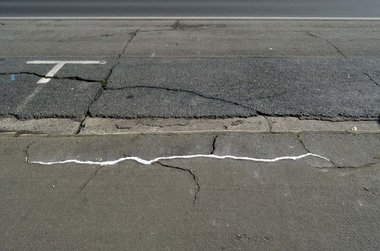
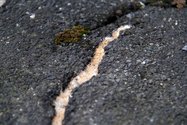
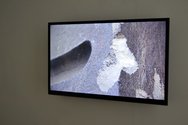

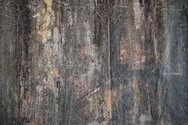
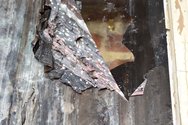
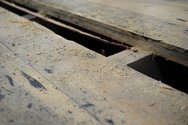
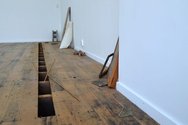
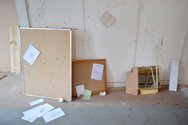
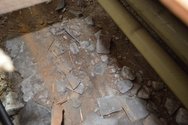
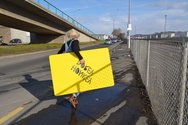

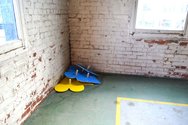
 Advertising in this column
Advertising in this column Two Rooms presents a program of residencies and projects
Two Rooms presents a program of residencies and projects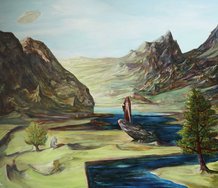
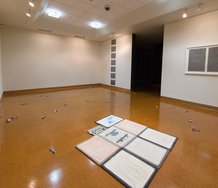
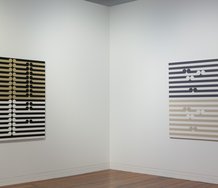
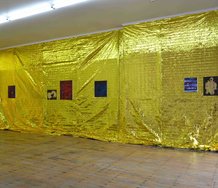
This Discussion has 0 comments.
Comment
Participate
Register to Participate.
Sign in
Sign in to an existing account.